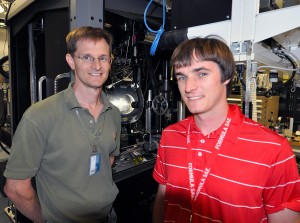WDTS departure
Christopher Nilsen
6/23/2014-9/4/2014
Chuck Mueller

Christopher Nilsen was one of the many of the students and faculty visiting the CRF under the DOE Office of Science Workforce Development for Teachers and Scientists (WDTS) program.
Damir Valiev
10/7/2013 – 9/1/2014
Jackie Chen

As a roving postdoctoral fellow in the Combustion Energy Frontier Research Center, funded by the DOE Basic Energy Science program, Damir Valiev has been at the CRF for a year performing a direct numerical simulation study of the interaction between the Darrieus-Landau (DL) instability and spatially periodic shear flow. Damir’s research shows that the DL instability plays a role in boundary layer flashback of premixed turbulent flames, actively contributing to flame acceleration through flame corrugation. Damir worked closely with Andrea Gruber, a visitor from SINTEF in Norway, Chung Law of Princeton University, and the CRF’s Jackie Chen. Damir has accepted a position at Umea University in Sweden, where he will focus on computational fluid dynamics (CFD) modeling of combustion and gasification of biomass particles.
Yongjin Jung
8/22/2013 – 9/1/2014
Lyle Pickett

Yongjin Jung visited the CRF from the Korean Advanced Institute of Science and Technology (KAIST), collaborating with Lyle Pickett, Scott Skeen, and Julien Manin on diesel fuel-air mixing and combustion processes. Yongjin characterized one of the Engine Combustion Network’s target injectors with multiple side-holes, identifying key differences compared to single-hole nozzles that affect the liquid and vapor penetration of the plume from each hole. He has returned to KAIST and will continue this work, including an investigation of how a time-varying plume spreading angle affects ignition and combustion.
Greg Lilik
7/16/2012 – 9/9/2014
Chuck Mueller

During his recently completed postdoctoral appointment with Chuck Mueller in the Engine Combustion Research Department, Greg Lilik focused on developing a laser-induced incandescence (LII) diagnostic that featured a vertically oriented and vertically propagating laser sheet. Thus configured, the diagnostic enabled soot visualization in the entire region above a diesel engine’s piston bowl, from the end of fuel injection to the time of exhaust-valve opening (and beyond). The datasets generated using this diagnostic, which have provided unique insights into soot production, oxidation, and distribution within the combustion chamber, are being used to assess soot models in computational fluid dynamic simulations. Greg is currently employed at the ExxonMobil Technical Center in Paulsboro, New Jersey.
Matthew Diefenbach
7/7/2014 – 9/10/2014
Scott Bisson

Under the guidance of Scott Bisson, CRF summer intern Matthew Diefenbach worked on an optical atom trap for gas trace detection. Specifically, Matthew helped develop the trap’s detection system, as well as precision lock loops for stabilizing the laser frequency used. Matthew’s work in the Remote Sensing and Energetic Materials Department provided him technical experience with lasers, atomic physics, and electronics—as well as valuable insights into performing research at a national laboratory. This fall, Matthew returned to his studies at California State University, East Bay, where he is completing a double major in chemistry and physics.
Eugene Kamarchik
9/6/2011 – 9/11/2014
Ahren Jasper

Working as a postdoctoral appointee in the Combustion Chemistry Department with Ahren Jasper, Eugene Kamarchik helped develop gas-phase theories of vibrational anharmonicity. In particular, Eugene focused on generating and applying new theories to predict highly accurate rovibrational (rotational-vibrational coupling) molecular properties at the high internal energies and temperatures relevant to combustion. His reformulation of the required high-dimensional integrals in terms of low-dimensional “intrinsic” properties enables significant efficiency improvements and provides a physical model for understanding vibrational mode coupling at high energies. In fact, the accurate vibrational properties obtained are key elements of the CRF’s emerging first-principles theoretical kinetics approach. Eugene left the CRF to take a permanent position as a developer at an Atlanta-based software company.